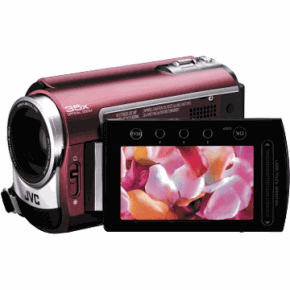
Pros: Small size. Sturdy. Zoom. Records to 30 GB hard drive. Affordable.
Cons: Light balance in low light a bit yellow in automatic. Not HD.
The JVC Everio GZ-MG330 is all about simple and easy. It’s not much bigger than my fist and packs in a 30 gigabytye hard drive for up to 37 hours of recording in the most compressed mode. This camcorder is so small, that on my way out the door, I’d see it on the table and just toss it in my jacket pocket. I didn’t worry about it getting banged around. It’s sturdy enough to handle it. I might stay out of the mosh pit with it, but otherwise, you’ll probably be fine. The body is entirely plastic, but the innards give it a bit of reassuring heft.
All the controls are simple and intuitive and right where your fingers expect them to be. The record button is by your thumb, and the zoom is on top along with a snapshot button for taking pictures. When you open the screen, which rotates 270 degrees, you’ll notice that there are no buttons, just indentations. You press your finger into these hollows where buttons should be and the camera responds. Works great as long as you’re not wearing gloves. There are five of these buttons along the bottom, including dedicated OK and MENU buttons as well as 3 contextual buttons whose operation changes based on the mode you are in. When they are active, their function appears on the screen above them. There is also a touch slider along the left side of the screen. As expected, it allows you to quickly scroll through options. It even has a cool blue LED underneath that shadows your finger movement. If you move your finger back and forth slowly, you can kinda get a cool Knight Rider effect, but you’ll get really strange looks if you try and demonstrate this to anyone. Trust me.
All that is great, but what really matters is the video quality. The MG330 records on a single 680k CCD sensor at standard definition 16:9 aspect ratio that produced videos with a resolution of 853×480 when downloaded. In even small amounts of daylight, the colors will be good and the autofocus will be fast. After the sun sets, you may need to make some adjustments. The default white balance or auto exposure (AE) setting was very warm, even in what I would consider well lit rooms. The footage had that yellow-orange tinge that gave us all the fake-tan look. This can be corrected by selecting from one of the other AE options in the settings menu. Also, the darker the environment, the tougher it was for the lens to focus. Once it ‘locked’ on the subject, it would usually stay focused, but sometimes it would take a moment to lock on and occasionally, it would decide to refocus unnecessarily. There is a mini LED light built into the front of the MG330 and it does help a bit, but only for subjects that are reasonably close. There is no mount for an external lamp or mic. The MG330 also has a stereo microphone. The stereo microphone differentiates the sound well, even in a noisy environment. When reviewing some party footage, I could tell which direction people off camera are coming from.
The images look very crisp when watching them on the 2.7″ widescreen LCD, but I wanted to see what it would look like when viewed on an HD TV, specifically my 32″ 1080i WinBook LCD. This monitor has a much higher resolution than the camera so I knew that it would highlight some of image deficiencies. JVC wasn’t helping here. The only video out is composite, not even s-video, which would have made a significant improvement. This added a good deal of fuzziness to what would have been a much crisper image. The downloaded files were much clearer when viewed on my 15″ MacBook Pro.
On the positive side, there is surprisingly little noise, especially in dark areas and large fields of colors. In some camcorders, dark areas are often made up of a combination of similalarly colored pixels that dance around constantly. This can be extremely distracting. With the MG330, black is black, solid black, and their isn’t any noticeable pixel activity in the background, with the exception of some slight aliasing at contrasting edges. On the critical side, as the camcorder moves to areas of different light intensity, light to dark or vice-versa, the aperture can take a moment to adjust. It’s a small lag, but noticeable.
When downloading the clips, I was at somewhat of a disadvantage. The JVC software only supports Windows and I only support Macs. Luckily, the camera connected easily and iMovie launched automatically. Files imported into iMovie very quickly, with ~40 minutes of video copying in less than 5 minutes. However, I was not able to take advantage of some of the various ways the camera can communicate with a PC. There are options to backup the files, play them on your PC, and burn a dvd directly. Selecting any of these when connected to a Mac just mount the camera as a disc in OS X and launch iMovie.
As you can see, all of my test footage was of my daughter at around a year old. I’m really glad I had this camera to capture some of those moments.
The MG330 has an MSRP of $449, but can be found for ~$100 less.
Bottom Line: If you want more features than a Flip Ultra and don’t need or want to pay for a true HD camcorder, give the JVC Everio GZ-MG330 a try. Good value for a point-and-shoot family video camera. Takes great images when the light is good.
[PSGallery=30i6yhcis10]